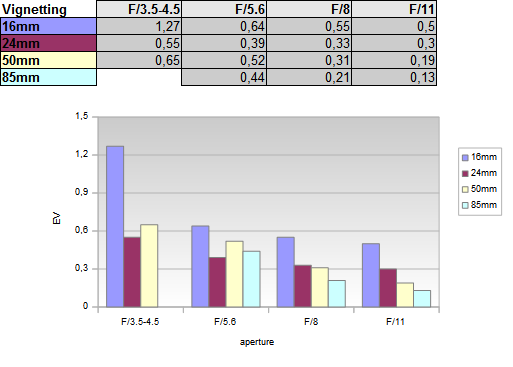|
Pentax HD DA 16-85mm f/3.5-5.6 ED DC WR - Review / Test Report - Analysis |
|
Lens Reviews -
Pentax
|
|
Page 2 of 3

Distortion
These days many users rely on distortion auto-correction either by the camera or via RAW converter. However, for purists it remains interesting to have a look behind the scenes (uncorrected RAW). Unsurprisingly the Pentax HD DA 16-85mm f/3.5-5.6 ED DC WR shows fairly heavy (3%) barrel distortions at 16mm. However, the issue is already rather irrelevant at 24mm followed by marginal pincushion distortions beyond.
Vignetting
The uncorrected vignetting is typical for most zoom lenses in this class. The HD DA 16-85mm produces a rather strong light falloff at 16mm @ f/3.5. However, the issue is mostly resolved f/5.6 already and it's not obtrusive at longer focal lengths even at max. aperture.

MTF (resolution)
The most interesting aspect of a (rather slow speed) standard zoom lens is surely its resolution characteristic and the Pentax lens doesn't disappoint us here. It shows a very homogeneous performance throughout the zoom range. The center quality is already high at max. aperture and excellent at mainstream settings. The borders/corners are good at 16mm @ f/3.5 and 85mm @ f/5.6 but otherwise they are really impressive especially in the middle range. As usual diffraction is a limiting factor at very small apertures but f/11 remains easily usable. The field curvature is comparatively flat.
In the past many of the tested Pentax lens have been plagued with centering issues. Unfortunately the tested sample wasn't perfect in this respect either especially around the 50mm mark (left image side). However, the problem dissolved at medium apertures at least. We used the readings from the right image side for the charts above.
Please note that the MTF results are not directly comparable across the different systems!
Below is a simplified summary of the formal findings. The chart shows line widths per picture height (LW/PH) which can be taken as a measure for sharpness.
If you want to know more about the MTF50 figures you may check out the corresponding Imatest Explanations
Chromatic Aberrations (CAs)
Lateral CAs are well controlled. At 16mm the average width stays around the 1px mark at the image borders with a more visible peak at f/3.5. The issue is quite negligible at longer focal lengths especially around 50mm.
 Note: Lateral CAs are actually quite constant across the aperture range but there's usually some parasitary fringing that "contributes" to the visible CA effect.
Note: Lateral CAs are actually quite constant across the aperture range but there's usually some parasitary fringing that "contributes" to the visible CA effect.
|